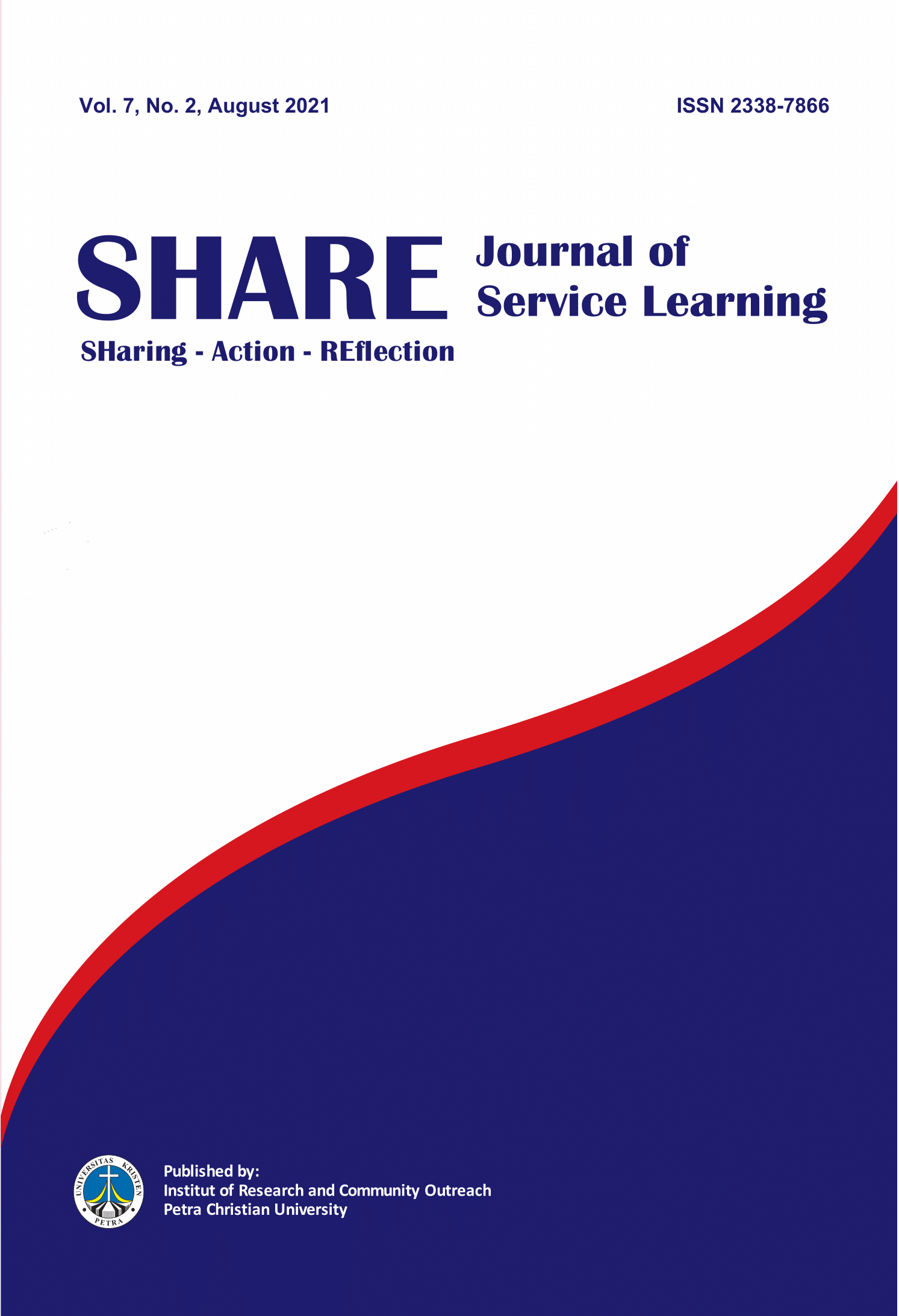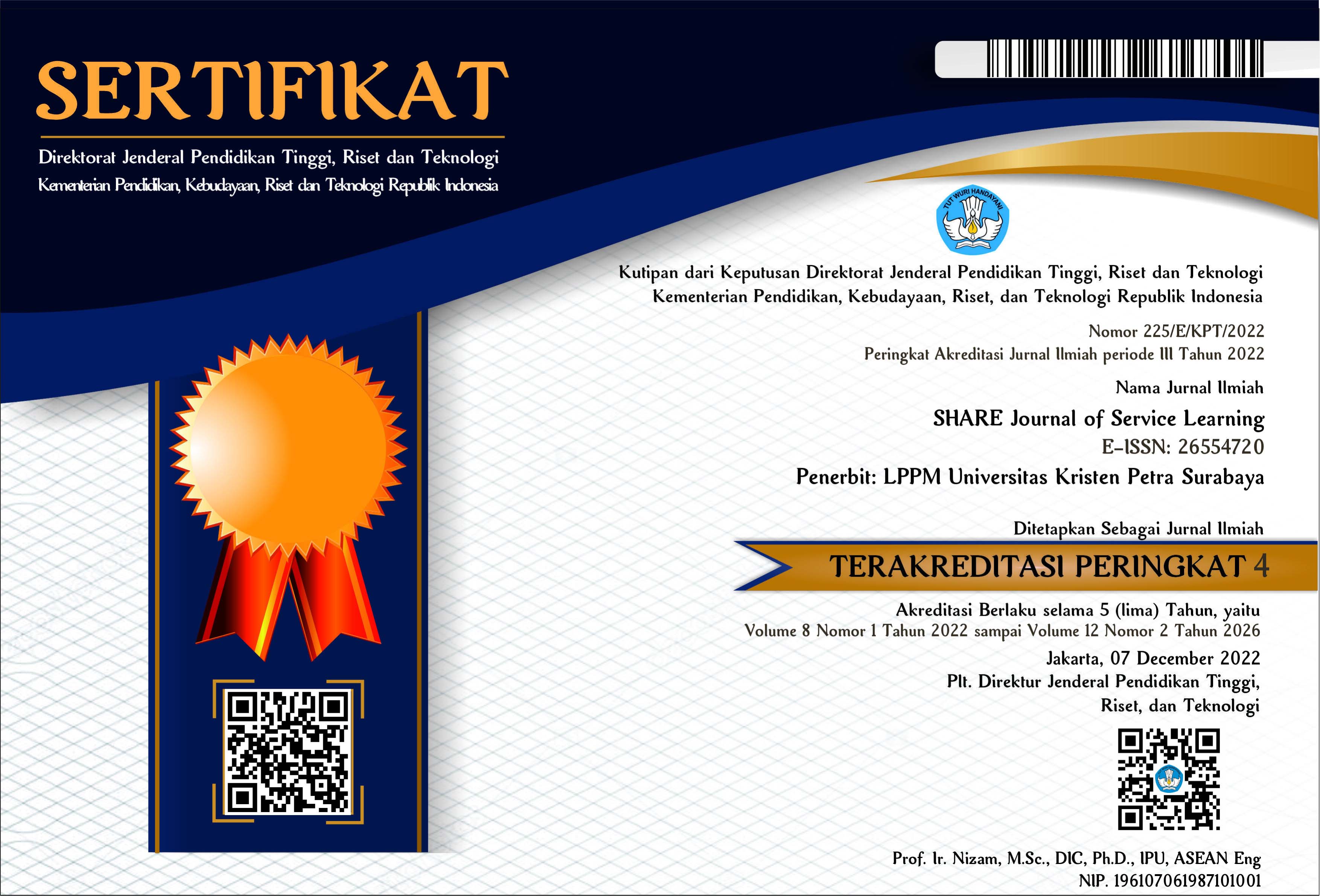MODUL UNIT KARANTINA PORTABLE SEBAGAI FASILITAS PEMBANTU RUANG ISOLASI DARURAT DI LINGKUNGAN KAMPUNG PADAT PENDUDUK
DOI:
https://doi.org/10.9744/share.7.2.78-85Keywords:
Isolation Room, Unit Module, Covid-19, ParticipatoryAbstract
The capacity of the isolation room at the hospital appointed by the Government to treat Covid-19 patients is no longer able to accommodate the positive Covid-19 patients. Positive Covid-19 patients with no symptoms or other signs of worsening physical conditions are advised to do self-quarantine and isolation independently. This self-quarantine/isolation becomes a problem especially in densely populated settlements, especially informal settlements. The case study on this community service activity is an informal settlement located along the Surabaya railroad. Together with the Surabaya ARKOM team as partners, this community service activity conducting field observations with the results that there are still many poor house conditions in this area, the conditions of the houses are tight and not fulfilled the standards of a healthy house, which causes a larger potential spread of Covid-19 virus and makes it impossible to carry out self-isolation in their each homes. The solution offered is to create a communal isolation room module as an emergency isolation room for informal village communities during a pandemic or can be used in other certain emergency conditions with a participatory design method that meets health standards for isolation rooms designed with the easy and fast module applications process. The purpose of this activity is to provide a set of modules for communal quarantine units as prototypes that can be made by the community with a simple system, easily available materials, fast and prioritizing community participation in its assembling.
Abstrak: Kapasitas ruang isolasi di Rumah Sakit yang ditunjuk Pemerintah untuk merawat pasien Covid-19 sudah tak mampu menampung membeludaknya pasien positif Covid-19. Pasien positif Covid-19 yang belum mengalami atau bahkan yang tidak menunjukkan gejala penurunan kondisi fisik, dianjurkan untuk melakukan karantina dan perawatan secara mandiri. Karantina secara mandiri ini menjadi tantangan tersendiri untuk permukiman padat penduduk, terutama permukiman informal. Menjadi studi kasus pada kegiatan pengabdian masyarakat ini adalah permukiman informal yang berada di tepi kereta api. Bersama tim ARKOM Surabaya sebagai mitra melakukan observasi lapangan dengan hasil menunjukkan bahwa kondisi rumah yang memprihatinkan masih banyak terdapat di area ini, kondisi rumah berdempetan dan tidak sesuai standar rumah sehat inilah yang menyebabkan potensi besar penularan Covid-19 dan tidak memungkinkan untuk melakukan isolasi mandiri di rumah masing-masing. Solusi yang ditawarkan adalah membuat modul ruang karantina komunal sebagai ruang karantina darurat bagi masyarakat kampung informal pada masa pandemi atau kondisi darurat tertentu dengan metode desain partisipatif yang memenuhi standar kesehatan untuk sebuah ruang karantina yang didesain dengan proses aplikasi modul yang mudah, murah dan cepat. Tujuan dari kegiatan ini adalah memberikan modul unit karantina komunal sebagai prototype yang dapat dibuat sendiri oleh masing-masing kampung padat penduduk dengan sistem yang sederhana (portable), material mudah didapat, cepat dan mengedepankan usaha partisipatif masyarakat dalam pembuatannya.
References
Cluster, S. (n.d.). 5 ways Shelter and Settlements programs help mitigate the spread of COVID-19. ShelterCluster.org/COVID19
Kusmadiana, I. H., Hodgkin, D., & Amri, A. (2020). Panduan Penyiapan Fasilitas Shelter untuk Karantina dan Isolasi terkait COVID-19 Berbasis Komunitas. https://covid19.go.id/p/protokol/panduan-penyiapan-fasilitas-shelter-untuk-karantina-dan-isolasi-terkait-covid-19-berbasis-komunitas
Listijono, John Budi H. 2020. “Apa Yang Kita (GBCI) Bisa Pelajari Dari Pandemi Covid-19,”.
Morawska, Lidia, Julian W. Tang, William Bahnfleth, Philomena M. Bluyssen, Atze Boerstra, Giorgio Buonanno, Junji Cao, et al. 2020. “How Can Airborne Transmission of COVID-19 Indoors Be Minimised?” Environment International 142 (May). https://doi.org/10.1016/j.envint.2020.105832.
Sundari, Titi, Vivi Lisdawati, Jahiroh, Ehwan Zunaidi, Deki Indrawanto, Farida Murtiani, Yohana, and Maya Marinda Montain Temmasonge Radi Pakki. 2017. “Peran Sistem Tata Udara Dalam Pencegahan Dan Pengendalian Infeksi Di Ruang Isolasi Airborne RSPI Prof. Dr. Sulianti Saroso Tahun 2017.” The Indonesian Journal of Infectious Diseases 4 (1).
Widodo, J. (2020). Petunjuk Teknis Pelayanan Puskesmas Pada Masa Pandemi Covid-19.
World Health Organization. (2020). Laboratory biosafety guidance related to coronavirus disease (COVID-19). Interim Guidance, 19 March, 1–5. https://doi.org/10.1016/j.ccm.2016.11.007
Wu, F., Zhao, S., Yu, B., Chen, Y. M., Wang, W., Song, Z. G., Hu, Y., Tao, Z. W., Tian, J. H., Pei, Y. Y., Yuan, M. L., Zhang, Y. L., Dai, F. H., Liu, Y., Wang, Q. M., Zheng, J. J., Xu, L., Holmes, E. C., & Zhang, Y. Z. (2020). A new coronavirus associated with human respiratory disease in China. Nature, 579(7798), 265–269. https://doi.org/10.1038/s41586-020-2008-3
Downloads
Published
How to Cite
Issue
Section
License
Authors who publish with this journal agree to the following terms:
- Authors retain the copyright and publishing right, and grant the journal right of first publication with the work simultaneously licensed under a Creative Commons Attribution License (CC-BY) that allows others to share the work with an acknowledgement of the work's authorship and initial publication in this journal.
- Authors are able to enter into separate, additional contractual arrangements for the non-exclusive distribution of the journal's published version of the work (e.g., post it to an institutional repository or publish it in a book), with an acknowledgement of its initial publication in this journal.
- Authors are permitted and encouraged to post their work online (e.g., in institutional repositories or on their website) followingthe publication of the article, as it can lead to productive exchanges, as well as earlier and greater citation of published work (See The Effect of Open Access).



















